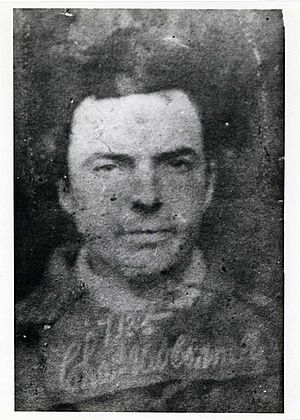Charles Underwood O'Connell facts for kids
Quick facts for kids
Charles O'Connell
|
|
|---|---|
 |
|
| Born | c.1839 |
| Died | 22 February 1902 New York
|
| Nationality | Irish/American |
| Known for | Irish republicanism |

From left to right: John Devoy, Charles Underwood O'Connell, Henry (Harry) Mullady, Jeremiah O'Donovan Rossa, and John McClure.
Charles Underwood O'Connell (born around 1838) was an important figure in the Fenian Brotherhood, a group that wanted Ireland to be independent from British rule. He was from County Cork, Ireland.
Charles O'Connell was one of "The Cuba Five". These five men were Irish leaders who were sent away from the U.K. in 1871. They were not allowed to return.
Contents
Who Was Charles O'Connell?
Charles O'Connell was born sometime between 1838 and 1840. He became a key member of the Fenian movement. This group worked to achieve an independent Ireland.
Early Life and Fenian Work
James Stephens was the founder of the Irish Republican Brotherhood (I.R.B.) in Ireland. He asked Charles O'Connell to help organize a Fenian group in his home county of Cork. O'Connell was very successful, and this group grew to include thousands of people.
To gain military experience, O'Connell traveled to the United States. There, he joined the Phoenix Brigade, a military unit. This unit was part of the 99th Regiment New York State Militia. They served during the American Civil War. O'Connell became a captain in this group.
His Arrest and Imprisonment
In 1865, British authorities discovered plans for a Fenian uprising in Ireland. These plans were found at Dublin Castle, the center of British rule in Ireland. Later, documents found in a newspaper called The Irish People led to the arrest of many Fenian leaders. The newspaper was also shut down.
Because of this, many people arriving in Ireland from the U.S. were checked carefully. On September 20, 1865, Charles O'Connell was arrested on a ship near Queenstown. He was found with Fenian papers and weapons that he had brought from the U.S.
O'Connell was found guilty and sentenced to 10 years in prison. He was sent to Portland Prison, where prisoners often worked in quarries.
The "Cuba Five" Exile
The U.S. government put pressure on the British government to release the Fenian prisoners. This was especially true for those who were U.S. citizens and had served in the American army, like O'Connell.
On January 5, 1871, many imprisoned Fenians were offered a chance to be released. Charles O'Connell was set free on January 7. Five of the released prisoners chose to go to the U.S. They agreed not to return to the U.K. They sailed from Liverpool on a ship called the S.S. Cuba.
When they arrived in the U.S., they received a huge welcome. They became known as "The Cuba Five." Charles O'Connell continued to work for Irish independence causes after his release.
Later Years and Legacy
Charles O'Connell continued to support Irish nationalist causes. Some people thought he might have returned to Ireland in the late 1890s for a meeting called the Irish Race Convention. However, his name was not on the list of attendees.
Charles Underwood O'Connell died in a large fire at the Park Avenue Hotel in New York on February 22, 1902. He was buried at Calvary Cemetery in New York.
Images for kids


